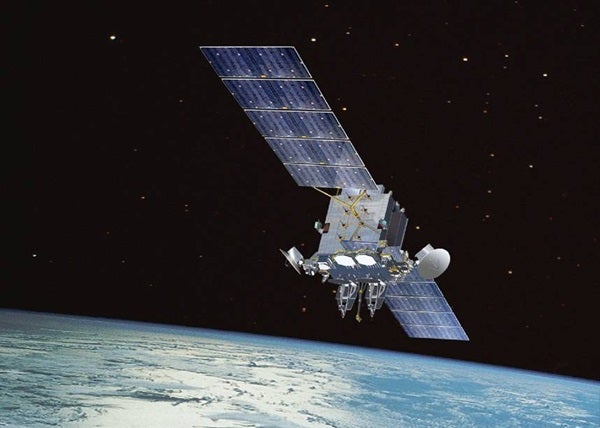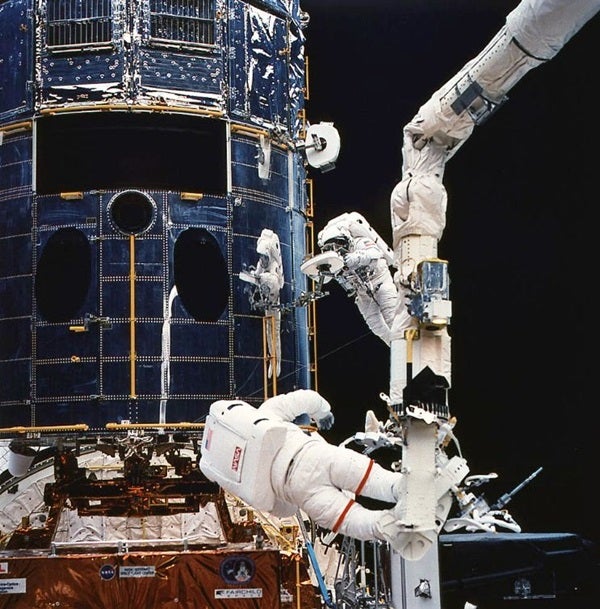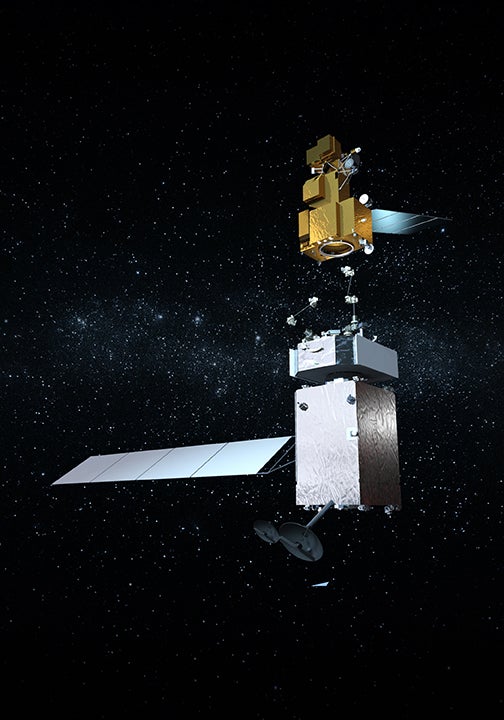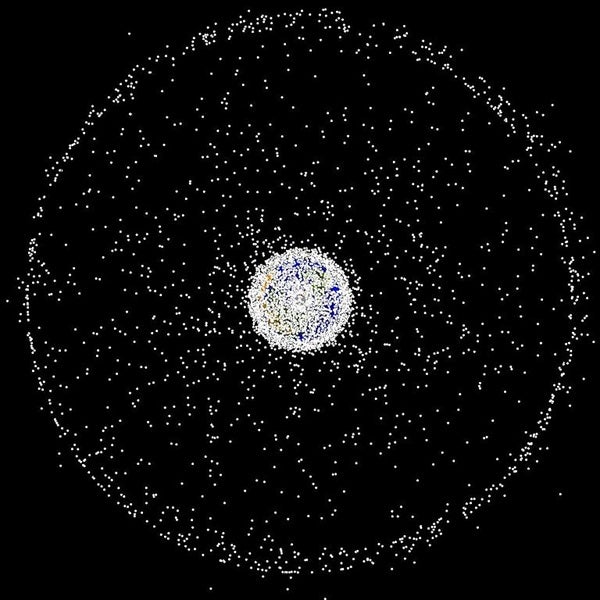The problem with this system is that the technology onboard the satellite may be working, but it all gets tossed away with the spacecraft simply because repairs or refueling are not possible.
“There is no other area of human activity where we build something that’s worth a half-billion dollars or a billion dollars, and never look at it again, never fix it, and never upgrade it,” says Gordon Roesler, program manager at the U.S. Defense Advanced Research Projects Agency (DARPA). “This is about changing that.”
Making repairs in space
Fortunately, the advanced robotics onboard new satellite servicing projects are intended to reduce the number of satellites facing this type of untimely retirement. Servicing spacecraft can repair, reposition, and refuel satellites using robotic arms, and will eventually be able to assemble satellites entirely in space.
Satellite servicing could eliminate the need for governments and companies to invest millions — and sometimes billions — into designing, building, and launching a replacement satellite every time repairs or fuel are needed. Servicing would also serve a national security role, as many government satellites relay critical information that shouldn’t be disrupted. The technology even has the potential to help humans reach Mars.
The United States government is working with Space Systems Loral (SSL), a commercial satellite manufacturer based in Palo Alto, California, to develop technology for two distinct satellite servicing projects.
First, DARPA is working with SSL on the Robotic Servicing of Geosynchronous Satellites (RSGS) program, for which Roesler is the program manager. DARPA and SSL seek to develop and demonstrate technologies that will enable cooperative inspection and servicing of satellites in geosynchronous orbit (GEO) — a high-altitude orbit about 22,300 miles (36,000 km) above Earth where many government and commercial communications satellites operate. This joint effort is expected to radically lower the risk and cost of operating in GEO.
SSL is also working on NASA’s Restore-L Mission, which will demonstrate servicing technology for spacecraft in low-Earth orbit between 99 and 1,200 miles (160 and 1,900 km). This is where the International Space Station (ISS), the Hubble Space Telescope, and many Earth-observation and research satellites are located.
“Space is a critical infrastructure for all of us today, and it’s something we often forget about because it’s the ‘invisible infrastructure.’ We see the roads, the electricity, and the water. We see all of these infrastructures, we don’t see the space one,” says Steve Oldham, senior vice president of strategic business development at SSL. “But space is now critical [for] GPS, weather forecasting, news gathering, television…but it’s the only infrastructure we have that isn’t serviced. It’s a throwaway culture.”
Oldham believes servicing will eventually become a day-to-day operation in space. And once it becomes routine, it will allow governments and companies to launch communications or exploration spacecraft in parts for robots to assemble in space.
“We have all these ideas about going to Mars, but it requires a lot of infrastructure to get there, and you don’t have the launch capability here on Earth to launch that type of enormous infrastructure,” Oldham says. “What space servicing and space robotics allow you to do is launch your exploration missions in parts and then combine them together.” Not to mention repairing them if something breaks on the multi-million-mile trip.
Robotic assembly will also help governments and commercial companies construct larger, more capable satellites, he says. “We can build satellites [whose parts] fit in two launch vehicles, join them together in space, and get a more capable satellite: more bandwidth, more power for communication, more sensors for Earth observation, for weather measurements, all those kinds of things.”
This robotic “roadside assistance” will be able to refuel, inspect, and repair satellites in space using advanced robotic arms that are even more mobile than human arms. These arms can perform tasks like using a specialized tool to clip the lock wire that holds a satellite’s fuel cap in place, inspecting a satellite from inches away using cameras, or updating and assembling satellite parts in orbit.
The robotic arms are part of an ecosystem of intertwined technologies, according to Laurie Chappell, a robotics expert and director of business development for emerging markets at SSL. Her experience includes developing a way to operate the space station’s robotics from the ground, so that astronauts onboard could focus on other responsibilities. “What we’re doing with the different satellite architectures is applicable not only to the geo[synchronous] communications satellites, but also to the Earth science missions.”
Chappell and engineer John Lymer, the chief architect for robotics and automation at SSL, are a husband-and-wife robotics team. Lymer was the chief engineer for robotics on the ISS; he also worked with the Canadian Space Agency to develop the state-of-the-art Canadarm, a robotic arm that can capture and repair satellites or hold astronauts.
The tasks performed by the servicing robots “will be mostly automatic, but when we get to the really tough problem of actually cutting the lock on a fill-and-drain valve, there will be a tool and a robot in space, and [a human] operator on the ground, and they’re going to be on joysticks, trying to get that tool in there and poking around a bit,” Lymer says.
The robots can perform tasks that otherwise require an expensive and resource-intensive astronaut mission, while also accessing areas in space that are hard or impossible for humans to visit. “The robots aren’t just there for the robots’ sake. They’re there because they’re enabling something different,” Lymer says.
“The pace at which technology is advancing on the ground is not normally realized by the aerospace industry. Ten- or 20-year old technology is routinely in orbit, because it is so expensive to send up the replacement,” says Ben Reed, the deputy division director of NASA’s Satellite Servicing Projects Division.
“Hubble broke that paradigm by having a servicing mission on average every five years … as opposed to 20 years for a typical satellite. As a result, Hubble is the most productive scientific apparatus humans have ever built. Why? Because of technology refresh,” Reed says.
The only spacecraft ever serviced on a regular basis are the Hubble Space Telescope and the International Space Station, according to Reed. Establishing a robotic servicing infrastructure will bring the same benefits to the thousands of other spacecraft in orbit not designed for servicing.
The technologies developed for the Restore-L Mission would also prove useful for future human exploration of Mars. “NASA is keen on this technology because it will help humans, one day, get safely to and from Mars,” Reed says. “We’re going to need rendezvous technology. We’re going to be transferring cargo from one vehicle or carrier vessel to another. Things are going to break and you’re going to want to be able to fix them without humans tending to them on the spot. So, a lot of technology we’re developing in Restore-L is applicable for that.”
Chappell explains that many of the architecture designs for Mars exploration missions involve transferring hundreds of tons of hardware between the Earth and Mars to create an infrastructure that would support human life. “Some of the technology we’re working on now is advanced propulsion so that you can cost-effectively and mass-effectively transfer huge amounts of cargo. For every group of people you put on the surface of Mars, like one rocket full of people on the surface of Mars, you need about ten rockets full of stuff to support them,” he says. “There will be, if you can imagine, in-orbit assembly of habitats that are in orbit around Mars, and then assembling things on the surface of Mars will be a mixture of both human and robotics at first.”
This surface assembly would be accomplished using “the natural resources from the location, because you don’t want to take everything with you, you want to use everything you can find,” says Lymer. “So digging and scraping and producing, that’s all got to be automated.”
DARPA’s Robotic Servicing of Geosynchronous Satellites Program
Geosynchronous orbit is home to hundreds of satellites that provide cell phone coverage, internet, TV access, and many other communications services to consumers around the world. These satellites also provide important information pertaining to government and military operations. With the RSGS program, DARPA and SSL are developing servicing missions for geosynchronous satellites to ensure they are functioning properly and that their technology is up to date.
Many satellites in this orbit are on a specific path called the geostationary arc, which follows Earth’s equator. Satellites in this arc rotate at the same rate as the Earth, facing the same point on the ground at all times. This makes them ideal for communications services like television, radio, and internet. But if the satellites have a problem or need repair, there is currently no way to fix them.
“The geostationary arc is so far away that it would take a lot of energy and a lot of fuel to be able to get that satellite back down to Earth [to repair or inspect it],” says Jennifer Dawson, SSL’s deputy technical director for RSGS. “So instead of bringing that satellite all the way down to Earth, we actually push it farther out into space, so they’re sitting out there at what’s called a graveyard orbit.”
Under the RSGS program, a DARPA-developed modular toolkit (the robotic payload), including hardware and software, will be joined to SSL’s privately developed spacecraft. DARPA’s role is to provide robotics technology, expertise, and a government-funded launch. SSL will provide the spacecraft to carry the robotic payload, as well as manage the payload, launch integration, and the mission operations center and staff. SSL has also formed a new company, Space Infrastructure Services (SIS), which will manage the servicing spacecraft and its in-orbit servicing missions. Together, they will create a commercially operated robotic servicing vehicle (RSV) that can make house calls in space.
DARPA has already designed and created the required robotic arms. RSGS seeks to demonstrate a suite of capabilities for the highly dexterous robotic arms that are both critical to national security and not commercially available at this time.
The ability to inspect and change payloads on a satellite is important for defense systems and other government missions. Adding and updating technology in space will provide reliable information and backup capabilities for some of the government’s most important satellites. Changing out and updating payloads will also allow companies and governments to update the technologies onboard. For example, a commercial internet provider could update a satellite to provide more dependable services to a region experiencing increased consumer demand.
“The other challenge for our customers is they’re typically trying to predict telecommunications needs in developing countries 15 years from now, but that’s a really tough problem for them to solve,” Dawson says. “[Changing payloads] really gives our customers the flexibility so that as markets change over the next decade, they can adjust their business case and not have to put in all that capital expenditure into building a brand-new satellite.”
SIS and SSL are also adding refueling capabilities to the servicing spacecraft’s design, which could extend the lifespan of satellites whose hardware and technology is still functioning. “What we’re learning is that even though our satellites are designed for 15 years, typically the fuel runs out before the hardware breaks,” Dawson says. These satellites are out of fuel — as intended — at the end of 15 years, but their hardware is still perfectly usable. Servicing, repairing, and refueling is also expected to save companies and taxpayers billions of dollars.
“Servicing on orbit could provide significant cost savings compared to current practices and a major advantage to the security of both commercial and Government space assets,” says Roesler. “The engineering challenges that need to be overcome to achieve this degree of facility at GEO are considerable, entailing significant technical risks but also carrying the potential for significant rewards. In addition to inspection and repair, RSGS robotics promise a new era in which satellite upgrades and enhancements at GEO are no longer just a dream.”













